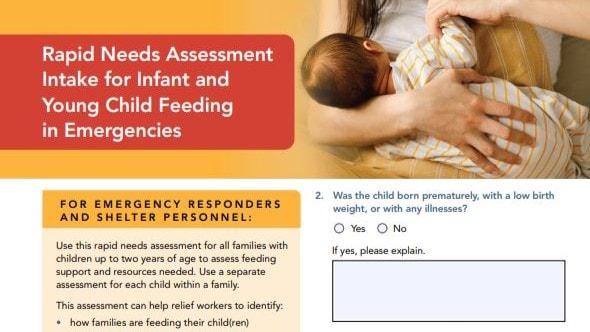What to know
Emergency responders and shelter personnel can use this rapid needs assessment to assess feeding support and resources needed for children younger than 2. Use a separate assessment for each child within a family.

Overview
This rapid needs assessment can help relief workers to identify:
- How families are feeding their child(ren).
- The foods and infant feeding supplies needed.
- Families that need lactation support.
- Families that require private spaces to feed their children.
- Families that require disposable feeding items or supplies to clean infant feeding items.

Download this fillable Rapid Needs Assessment Intake Form. It can be filled out electronically or printed and filled out by hand.
Responses to the assessment
After completing the Rapid Needs Assessment, use the responses to inform the following steps.
Reassure breastfeeding women that breastfeeding is the safest way to feed their child during an emergency. Tell families they can and should continue to breastfeed as much as their infant wants.
Provide families with age-appropriate information about how to continue to safely feed their children during the emergency. Tailor education to how they are currently feeding their children. This education should include recommendations for safe cleaning of feeding equipment for families, including those providing complementary foods. Refer to the Recommendations for Feeding Solid Foods During an Emergency handout in CDC's IYCF-E toolkit for more information.
Breastfed infants may be separated from their mothers or lack access to breast milk. If pasteurized donor human milk is available, ensure that breastfed infants who are separated from their breastfeeding mother and/or do not have access to breast milk are able to receive it. Such milk can be obtained from human milk banks.
Encourage mothers to breastfeed at the breast more. If families are using a breast pump to express milk to feed their child, encourage them to breastfeed at the breast more and/or hand express their milk for feedings. Refer to CDC's handout on hand expression.
Help mothers using an electric breast pump to use it safely. Make sure they have access to:
- Electricity and/or batteries to operate the pump.
- A refrigerator to store their milk.
- Safe water and cleaning supplies to properly clean the pump part kits after every use. If proper cleaning of breast pumps (manual or electric) is not possible, they should not be used. Contact a lactation support provider to help support the family and teach hand expression.
Provide disposable cups and instructions on cup feeding, if needed. If families are using bottles and nipples, or other reusable cups to feed, and safe water and cleaning supplies are not available, provide disposable cups and instructions. If proper cleaning of infant feeding items such as bottles and nipples is not possible, they should not be used. Refer to CDC's handout on how to cup feed.
Provide education on proper cleaning practices, if needed. If families are using bottles and nipples, or other reusable cups to feed, and safe water and cleaning supplies are available to clean these items, provide education on proper cleaning practices. Note: Disposable feeding items are preferred in group shelter settings to minimize risk of contamination.
Help families find support. Let families know how they can get help with infant feeding if they have any concerns or problems.
Further assessment
Consult with a trained health professional or lactation support provider if:
- A child appears unwell, thin, or dehydrated (get medical help immediately).
- A child is normally fed breast milk but is separated from breastfeeding mother.
- A child not breastfeeding well (latch, suck, or transfer).
- There are breastfeeding problems, such as (e.g., plugged ducts, breast infection, thrush, engorgement, slow or difficult let-down, oversupply, or use of special equipment like a supplemental nursing system or G-tube).
- The parent/caregiver thinks their child is not eating enough.
- A mother thinks she is not producing enough breast milk for child.
- A breastfeeding family requests infant formula because they are having problems with breastfeeding.
- A child is over 6 months of age, and their family has concerns with feeding the child complementary foods.
- A mother needs to learn how to hand express milk.
- A mother wants to relactate. Relactation is when a mother starts breastfeeding again after having stopped for some time (weeks or months).
- A child has food allergies or dietary restrictions.
